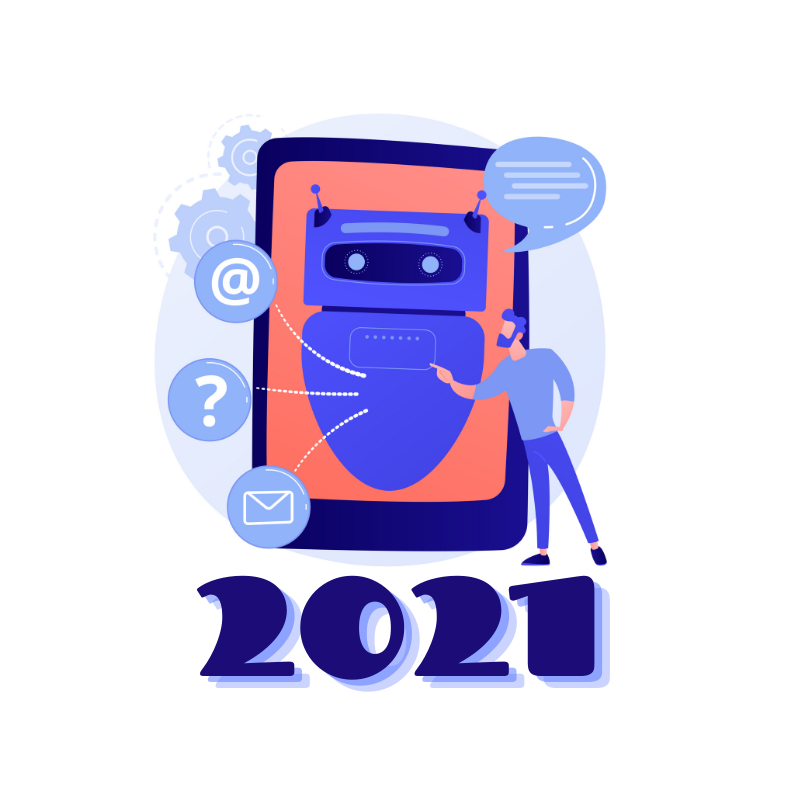 |
submitted by /u/Botmywork [link] [comments] |
Month: July 2021
-
How Conversational Commerce Helping Online Retailers?
-
SEO Agencies And Chatbots Integration Into Their Everyday Business Operations
SEO Agencies And Chatbots Integration Into Their Everyday Business Operations
Chatbots have come a long way from an overhyped industry that was initially thought of as a new world order in commerce to a calmer approach nowadays. Still, a huge number of businesses employ chatbots, and we will discuss in this article how they can be used in an SEO agency for better efficiency.
What is a chatbot?
A chatbot is an application/software which is connected to the chat channel you use, be it on-site chat or your chat channels on social media like Facebook Messenger. Then the chatbot reacts programmatically to the user input.
There is a huge number of different chatbots with different capabilities, and before starting to implement one you need to do some research on what they’re capable of and how that matches with what you plan to do with it.

What can chatbots do for an SEO agency?
Chatbots generally work in two ways:
- They react to human language messages entered by users. Think of some rules like “answer “hi” if the user enters “hi” — however, this is a very simplistic example and such rules can be eternally more complex, involving AI/ML trying to decipher the user’s sentiment or intent.
- They offer the user some choice to make and the follow-up with it. Think of a screen showing up in chat saying “hi, what would you like to learn about?” and three buttons like “SEO services”, “Pricing Plans”, “Website Audit”. And when the user clicks on a button of the choice, the chatbot continues with that flow offering more choices or asking clarifying questions.
Such flows can be very complex, nested, and mixed, depending on the logic you want to follow with customers’ queries/actions in a bot.
Another important aspect of chatbots is that they often have an escalation mechanism designed to reach a human agent when the user feels that the bot can’t help him. Or it can be done by the bot itself when it doesn’t “understand” the entered query by the user.
Trending Bot Articles:
2. Automated vs Live Chats: What will the Future of Customer Service Look Like?
4. Chatbot Vs. Intelligent Virtual Assistant — What’s the difference & Why Care?
Repeated responses
Hardly anything annoys a customer chat specialist more than having to type “hi”, “thank you for your request”, and other such things tens of times a day to different customers. Chatbots are a great resort for this type of routined responses and they can be set up to respond with different phrases of the same meaning, to avoid a “robotic” feeling.
Customer support
Offering customer support 24/7 is another great use for chatbots. Not every request can be sorted out via chatbot. But if we think about how many similar requests are handled every day by customer support, it becomes clear that a lot of them can be automated.
Two of the most common customer requests are regarding payment methods and how-to questions. These are easily programmable as rules for certain keywords being present and turned into automated responses.
If you run an SEO agency, you definitely have your own typical, often heard questions from the customers which can probably be also automatically replied to with relevant information, while your customer support staff focuses on more complex support tasks/requests.
You may not have a human operator ready 24/7, but when the user wants to escalate to talk to an operator, the chatbot can reply with timeframes when there are live operators available.
Sales funnels/lead nurturing
Probably any SEO agency uses a variety of techniques and magnets to nurture potential leads. These can be free website audits, case studies, PDF guides, webinars, free consultations, etc.
Chatbots can be used to help with this. If the customer interacts through a chat channel, the chatbot can clarify the needs, offer to send a link to an appropriate guide, and later invite to a webinar or consultation. Depending on the bot functionality, it may be even deeply integrated with your calendar like Calendly, so you’ll see the appointments are lining up right there.
Order processing
Many companies from pizza places to e-commerce shops turn to chatbots in helping customers make an order. While your SEO agency has a different flow than ordering a pizza, still a lot can be automated through a chatbot.
The customer wants a new invoice — here it is. The customer wants to upgrade a plan — surely. The customer wants to pay by card — no problem, they can do it right in the chatbot.
How to choose which chatbot to use?
There are many chatbots available. The best place to start is to identify what you want your chatbot to do, and in which channels.
If it’s your socials you want to automate a bit, the functionality can differ or be not available at all, as the technical capabilities and what is allowed for chatbots differs on social media. E.g. chatbot simply cannot follow-up on Facebook to users after 24 hours of the user’s last input, while on Twitter it is OK.
Here are some things to consider when choosing a chatbot for your website:
- Supported channels in addition to on-site chat;
- Multilingual interface — if you have customers from different countries;
- Integration — if you want to get the customers and their dialogues into your CRM;
- Automation — what sort of rules/autoreplies and such the chatbot can run.
When you understand the typical scenarios you want to pursue, you may start looking for chatbot solutions. For example, ManyChat is one of the famous chatbots for Facebook (and now — Instagram, as until the 2nd of June, 2021, any chatbot automation in Instagram was not available via API).
https://miro.medium.com/max/2602/0*gro7azyduvRhudgp
It is free by default, but many useful features and templates become available on paid tier. If you’re looking for an on-site embedded chat service with options to run email newsletters, there is a widely known communication platform HelpCrunch.
However, we strongly suggest that you make your own choice after carefully weighing your chatbot needs.
Track the performance after the chatbot implementation
All in all, the whole purpose of employing chatbots is to either increase conversions or increase customer support satisfaction, or both.
You can easily track your conversions via Google Analytics or your internal statistics, and most chatbots offer the option for users to rank their satisfaction with the chatbot experience. If you find it fairly low, probably, you need to rethink the chatbot functionality or scripts.
Also, you should track the average session length and bounce rate after implementing a chatbot. If the bounce rate has become higher with a chatbot, perhaps, it doesn’t work properly, or the popping-up chat annoys users.
Adding a chatbot to a site can negatively impact the user experience, which is extremely important to rank well in search engines, and the recent introduction of Core Web Vitals by Google is just another supporting proof for that. Your site should load extremely fast, not have any troubles with the layout and input delays. This is why after you set up a chatbot on your site, you need to run an audit via one of the professional tools like SE Ranking.
Summary
Chatbots are great tools to replace humans in repeating tasks. Be it saying “hi” in response to “hi” or running ever-repeating same conversations regarding your services, chatbots can run mundane communication tasks easily leaving human input needed only to really complex issues.
Try connecting them, and you’ll love how chatbots will make your sales funnel or customer support easier!
SEO Agencies And Chatbots Integration Into Their Everyday Business Operations was originally published in Chatbots Life on Medium, where people are continuing the conversation by highlighting and responding to this story.
-
Support Teams — A Better Slack Experience with Bots
Support Teams — A Better Slack Experience with Bots
Cal Newport is one of my favorite authors on productivity. I’ve been reading his blog on deep work since sophomore year of college. He recently penned an article for the New Yorker titled, “Slack Is the Right Tool for the Wrong Way to Work”.
As the founder of a digital agency that builds websites, I’m always getting added to Slack channels. I’m normally in anywhere from 6 to 8 groups — with each group containing 4 to 6 channels. Then we get added to productivity tools, issue tracking software, different accounting programs, new niche CRMs… If the to-do list doesn’t overload my day, remembering the day’s dozen different groupchats always tips the scale.
The average support team has considerably more fires to put out. Is Slack the right tool for them? Is Slack the right tool for me? It can be — but only if used correctly.
‘Sorry, we can’t join your Slack’ argues that agencies would be much more productive without joining these instant messaging tools. After all, how often does a notification interrupt your workflow? If you can have more uninterrupted room to focus on meaningful deep work, you can deliver better results for clients.

These think pieces feel like convincing arguments, however, nuanced conversation about project details just won’t suffice over email. It’s important to remember Slack should be used as more than a blank slate. Stewart Butterfield wants us to customize our Slack groups to fit personalized needs. Slack is not the wrong way to work — it simply requires our conscious effort to add relevant tools, applications, and bots that solve these productivity problems.
Just like the app store, the Slack App Directory is the real place to add apps that get work done. Like most marketplace companies today, the number of Slack-centered tools, bots, integrations, and apps increases every single day. This is a relatively new ecosystem which makes it difficult for any team to know which tool works best.
This article is intended to help enterprise support teams compare and contrast the most helpful Slack bots. I examined HelpDesk+, Halp, and AtSpoke to offer a synopsis of my favorite, recommended tool.
I’ll put the TL;DR right here.
My favorite is HelpDesk+
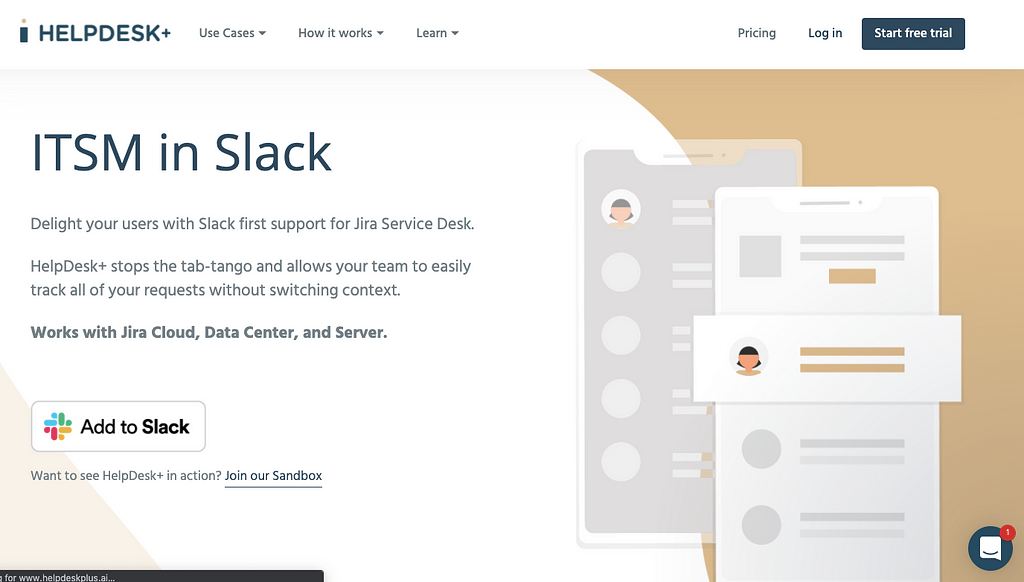
How many tabs do you have open right now? HelpDesk+ is a defense against the tab-tango. It’s a process where users can support themselves as they search for information and ticket info.
It’s support for support teams.
This is my preferred way to track requests and streamline support work. I don’t have to login to an excessive number of apps or portals because everything I need to know is in Slack. That already saves me a significant amount of time.
HelpDesk+ reduces the amount of context switching I have to do, which decreases my time wasted on repetitive workloads. This is far better than quitting Slack and relying on email for following in-depth conversations. Slack hacks like this add up quickly to create the time and space I need to focus on building.
This integration lets you search, create, and transition new requests. Then their routing process uses auto mapping to memorize these JSM request types. That means similar future issues can be answered as soon as they’re asked. Approvals take place in Slack so I can focus on the next to-do instead of pseudowork!
Trending Bot Articles:
2. Automated vs Live Chats: What will the Future of Customer Service Look Like?
4. Chatbot Vs. Intelligent Virtual Assistant — What’s the difference & Why Care?
There are other integrations coming soon but their existing integration with knowledge base in Confluence is super helpful. HelpDesk+ was created by some really interesting Slack developers who also make other tools that increase meeting efficiency and integrate with Jira.
Halp is a simple conversational ticketing solution which allows IT and Op teams to be more organized and efficient! This effectiveness is achieved by assisting teams in assigning, prioritizing, managing, and reporting requests from Slack.
Any team can improve their everyday communication with new abilities to track, automate, and most importantly, understand workflow. They’re trying to help remote teams move towards both happiness and productivity.
AtSpoke is another workplace ops tool intended to assist IT, Dev, and other teams in creating a more efficient conversational experience. They emphasize their focus on whatever subject matters, as opposed to solely focusing on a ticketing system.
While their system is good for conversational ticketing, it also auto-resolves tickets and automates repetitive agent tasks so teams can do more for less. AtSpoke is a good way to accelerate company-wide support work.
In summation, I liked HelpDesk+
Don’t forget to give us your 👏 !



Support Teams — A Better Slack Experience with Bots was originally published in Chatbots Life on Medium, where people are continuing the conversation by highlighting and responding to this story.
-
Is Kuki available as an open-sourced API for use in other works?
I remember that several months back (when Kuki was still known as Mitsuku no less) that you could pay to use Kuki’s API for use in other projects. Is this still available to the general public?
submitted by /u/Toxinz1181
[link] [comments] -
21 Ways to Grow your Business with Chatbots in 2021
Introduction
Chatbots for business and website have been absolute game-changers in recent years. They are redefining the rules of business communication, thanks to the wonders of Artificial Intelligence.
21 Ways to Grow your Business with Chatbots in 2021
1. Customized Experience For Consumers
Chatbots for businesses or websites feature an in-built natural language machine learning technology. This technology equips a chatbot for the website to comprehend customer questions accurately. Thus, chatbots are capable of providing personalized shopping advice to every single customer they interact with.
A 2019 survey reveals that twice as many buyers were willing to interact with chatbots as they helped provide useful product recommendations. The chatbot for website used by Nordstrom has a step-by-step item display system. It enables the chatbot to showcase products based on the buyer’s choice.
There are several chatbot builders in the market. But choosing WotNot will add an edge to the customer experience as our impactful chatbots for business maintain no code.

2. Manages Sales Seamlessly
Chatbots for small businesses help automate the marketing process. They can efficiently handle routine tasks of generating leads, collecting data, and interpreting it simultaneously. They do all this in the nick of time.
Using chatbots is worth a try for small businesses because it automates the streamlining of sales from the beginning till the end. Bots can help manage a small business as they can single-handedly generate leads, convert buyers, and offer the best consumer service. Thus, a business need not dole out huge capital because chatbots can manage an enterprise all by themselves.
This saves any business enterprise from attending customers personally because chatbots as an AI tool are pretty intelligent to communicate with millions of customers at a personal level.
An interesting use case in this regard is Snaptravel, an online hotel booking company.
This company used an AI chatbot to build an automated sales executive. This bot can book hotels and flights for Snaptravel’s clients based on their timing and budget. If the chatbot cannot handle any issue, it will redirect the client to a live representative. Thus, a chatbot manages most parts of a business very efficiently.
As chatbots for website are already boosting sales and increasing customer satisfaction, there is a growing demand among corporates to make their sales AI-driven. Studies predict that the international chatbot market will reach USD 1.3 billion by 2025, expanding at a CAGR of 24%.
3. Expands Engagement Opportunities
Using chatbots as virtual assistants on a company website is an effective way of improving customer engagement. As the chatbots function using conversational technology, it increases a website’s chances of having a better engagement with the customers. Besides, a survey reveals that 39% of businesses use chatbots to impart an interactive interface to their websites.
The ability of chatbots to process natural language and interpret customer’s mindsets makes it a hot pick among brands who want to speed up their interaction with their customer base. A significant use case is Slush, a company that organizes international entrepreneurial events all over the world. The chatbot on Slush’s website handled 64% of the customer requests successfully. The customer engagement saw a dramatic increase of 55% after Slush roped in a chatbot on their team.
Another useful instance is that The Plum app uses a chatbot that welcomes first-time visitors by asking if they would like to learn more about it. If the user selects ‘yes,’ the chatbot starts teaching how the Plum mobile app functions.
Trending Bot Articles:
2. Automated vs Live Chats: What will the Future of Customer Service Look Like?
4. Chatbot Vs. Intelligent Virtual Assistant — What’s the difference & Why Care?
4. Increases Revenue and Leads
When chatbots are incorporated into a business website, they immediately initiate a conversation to gauge a customer’s intent every time they visit the brand website. Using chatbots for website is an effective mode of interaction as they can provide immediate solutions to the customers. This simplifies the sales process and helps produce ‘leads’ faster.
With surging demand for chatbots in the business domain, vital statistics reveal 36% of businesses are using chatbots to increase their sales leads. At WotNot, we build hi-tech bots for managing business leads seamlessly.
5. Manages Business Faster By Automation
Chatbots leverage the technologies used in running businesses efficiently by making aspects of e-commerce completely auto-driven. In short, chatbots for website speeds up business growth. Automation by chatbots minimizes business costs by replacing manually executed customer service.
According to a study, 67% of businesses of customers used chatbots-based customer support for speedy responses. Buyers can chat with car brand Skoda’s chatbot Laura to talk about their specifications, budget, etc.
6. Enhanced Analysis Of Consumer Feedback
Chatbots for small business analyze a user’s sentiments through Natural Language Processing (NLP) to identify emotions from a given text. Sentiment analysis will tell us if the consumer’s response is positive or negative.
NLP powers chatbots with the ability to decode a customer’s mindset after a conversation and develop insights into their preferences. Thus, a chatbot can showcase recommendations based on a customer’s likes. This helps a business adopt a customer-centric approach while redefining marketing efforts.
For example, angry customers at the beginning of a conversation are immediately identified and directed to a live rep. Hence, the customer will get personalized assistance efficiently and quickly. At WotNot, we build smart bots which handle customer queries with spot-on responses.
7. Ensures Longevity of Start-Up Businesses
Chatbots for website increase the possibility of start-up retention as their interactive interface predicts consumer issues by providing effective solutions. Start-ups need not hire executives to maintain 24/7 customer service, as chatbots play virtual assistants effortlessly. This reduces business expenses to a considerable extent.
Chatbots remember and process the information which customers tell them. Chatbots for business can also make recommendations based on the data gathered from past interactions with a customer. Thus, we can serve our customers better by using this data as a valuable consumer resource.
The chatbot of Snaptravel stores the data of buyers to generate leads. Then the chatbot sends rapid alerts for discounts and promos via social networking platforms like Facebook messenger, Whatsapp, or text.
8. Use of Chatbots On Social Channels
Chatbots for business use the data provided by users on social media forums to prepare personalized messages. Based on that data, bots can field questions and provide relevant information like any human consultant. In this way, chatbots can convert leads into trusted buyers.
The pervasive presence of chatbots on all social networking platforms paves the way for any brand to find its customer effortlessly.
Kindred Bravely, an eCommerce store, uses Facebook Messenger chatbots for providing a conversation-oriented buying experience for the customers. As per the reports of a 2019 survey, Company CIOs have accepted the usefulness of chatbots for better outreach.
9. Makes Interaction Fun
As of 2019, the world comprises 1.92 billion consumers who are buying digitally. Most of us love using visual expressions while chatting as it helps us connect better. Thus, chatbots for website can rev up sales and increase conversion rates by using funny emojis for a social engagement with the customers.
Cosmetic brand Sephora used chatbots on the messaging platform Kik to attract youngsters with a visually interactive interface. Its second chatbot, ‘Sephora Virtual Artist,’ allows its customers to upload a selfie and try different lip colors. It has provided a delightful experience to its users.
10. Guides Customers In Real-Time
A chatbot makes use of machine learning to proactively respond to basic buyer queries such as “How much does this item cost?”. They are providing instant solutions round the clock. Also, multilingual bots can chat with a customer in his/her mother tongue, leading to a higher degree of satisfaction among the customers.
The chatbot is the easiest way of localizing knowledge bases, FAQs, and web pages based on our customers’ demography. For example, H&M’s chatbots can assist their buyers in finding products with the exact size and fit. Their chatbot provides information on choices, style guides, and prices, helping H&M enhance buyer’s shopping experience.
11. Makes Your Business Website Contextual For The Consumers
A bot provides value-oriented, contextual assistance to the customers. It uniquely processes the data it has on the customer through AI to give the customers a formative experience.
This is because a chatbot uses a customer’s data to provide them a personalized experience. These bots can do more than just answering pre-programmed queries. For example, a chatbot can develop useful recommendations by analyzing data on an individual customer’s preferences.
A major use case for bots in speeding up consumer service is the HDFC Bank chatbot. This chatbot is available round-the-clock to assist with banking inquiries. The availability of 24/7 customer support increases the customer retention rate for any enterprise.
12. Provide Support During Emergency
Chatbots for business can develop immediate resolutions during an emergency, especially if it is after hours. If a company maintains a chatbot to cater to customer service, it can provide instant assistance instead of making customers wait on hold for resolving non-complex issues.
The instance of crisis communication chatbots is a good example in this case. These chatbots are relentlessly helping medical workers to keep themselves up-to-date during the COVID-19 crisis. They provide accurate responses to queries even when crisis center reps are not able to.
13. Close the Sale On Customers
Chatbots for website can lead a business to have a clear and definite path to ROI (Return On Investment). It guides customers through the sales funnel by providing customization at scale. 57% of companies admit to chatbots delivering huge ROI with minimum effort.
Charter Communication is a cable provider in the US. It had 200,000 live chats every month before they had a chatbot service. When they started using one, the chatbot managed a whopping 83% of the total communications. Charter had a boost in the ROI by 300% within six months.
We, at WotNot, are going to drive business ROIs like never! Our chatbots personalize every customer’s experience and scale up sales in the nick of time.
14. Makes Your Team Productive
Chatbots can create coordination between various departments of a business enterprise. They can establish communication channels between sales, customer service, and lead generation for the smooth running of businesses.
- Awareness — The use of chatbots can make a sales funnel a consumer-oriented channel in the true sense.
- Interest — As a first step, chatbots can quickly attract customer attention to the company website. Then, a chatbot can keep a customer hooked on buying a product displayed on a site by answering the buyer’s questions. This will help the customer to decide between buying a product.
- Decision — Furthermore, tailoring a sales chatbot to say the apt things at the right time will convince a buyer to buy a product.
- Action — Thus, a top-class chatbot can prompt and motivate your customer to complete the purchase.
As a use case, a chatbot can work as a virtual assistant for teams within an enterprise. Bots can respond to common queries, find solutions, or search a database for product statistics. Bots, using AI, can find the data that the sales agent needs about the brand’s service or products. This helps sales agents to be faster with their responses.
15. Manages Order Tracking
Tracking your shipment through email is a complicated process. A chatbot can make the process of tracking orders very easy. Buyers can just enter the shipping ID there and get a notification.
Lifestyle brand Zalando’s chatbot provides immediate order tracking for its buyers after ordering a purchase.
16. Enhances Brand Value
Chatbots for business can speed up the functioning of a website in various ways. It keeps the engagement with customers simple, funny, and straightforward. All this adds to the positive experience of a visitor on a site.
The chatbot of Dominos makes the ordering process go smoothly for the customers. They need not open the website or download an app to order a pizza. They just have to join a conversation with the chatbot in Messenger. Statistics reveal 74% of buyers prefer chatbots for instant answers.
17. Provide Price Estimates
Before buying a product, a customer may try to get in touch with the service agents requesting its price. Chatbots for business have direct access to the business database. Hence, they can recognize keywords in a buyer’s request. Consequently, they come up with prices for the products.
The chatbots of Staples serve this purpose. It quotes the price underneath the product image only if that item is in stock. The chatbot has a ‘shop now’ button beneath the image to click on it and purchase the product.
18. Monitor Drip Campaigns
There is a growing tendency among consumers to neglect opening company subscription emails. However, a chatbot engages the customers in a chat by asking them multiple questions.
Many visitors will take part in the survey due to the conversational approach of the chatbot. The company can then send emails with more relevant content to the users for marketing drives.
Having a tête-à-tête with chatbots is going to be more entertaining now. We, here at WotNot, are all set to take conversations with customers on a different level using top-rated AI-powered chatbots.
Sales engagement platforms are developing chatbots that provoke thoughtful discussions among their users on behalf of the concerned company. Furthermore, they attempt to seek answers to questions before asking for the visitors’ emails.
19. Equipped With Selling Tactics
A chatbot guides a potential buyer about a brand’s services and products. Hence, it can take this chance to direct a buyer to a lucrative upsell or a down-sell offer. By this time, the customer concerned already has an idea of the company’s products.
So, the customer will seriously think about accepting the offer being shown by the chatbot. This can boost up the sales.
HelloFresh, a food delivery service, offers chatbot-exclusive rebate codes to track the exact number of orders they receive through their chatbot.
20. Promotes New Products
Companies can promote their latest launches by providing a personalized experience to the customers through chatbots.
Chatbots can converse with the visitor to know about the types of products they like buying and give highly relevant options. Through chatbots, a company can boost its sales.
A fashion brand, MVMT, similarly uses chatbots for business to attract millennials to boost their sales.
21. Conducts Promotional Contests
Companies promising discounts via contests improve their chances of customer loyalty. Chatbots ensure higher visibility for a contest on a business site so that visitors can access them without any hassle.
The chatbot of the National Geographic website engages participants through a quiz and offers a discount on their Almanac eBook.
Conclusion
The chatbot market is growing by leaps and bounds. With the robust enthusiasm centering around chatbots for website, it is expected that customers will readily forge a relationship with a company without asking for human interaction. With 53% of organizations hoping to use chatbots, the day is not far when the power of chatbots for business will be a force to reckon with. To take sales to new heights, trying WOTNOT is worthwhile. We build highly advanced bots with no code that functions across multiple channels. Our live chat tool helps you bond with your customer base in real-time. And, in a data-driven world, the WOTNOT chatbot analytics dashboard helps a brand develop a deeper insight into its customer base and bolster its sales.
Don’t forget to give us your 👏 !



21 Ways to Grow your Business with Chatbots in 2021 was originally published in Chatbots Life on Medium, where people are continuing the conversation by highlighting and responding to this story.
-
Building a Chatbot using Chatfuel

Image Source: Botfuel We will create a chatbot that will act as a city tour guide for the user or tourists. The chatbot conversations will include tourist conversations such as nearby places to eat, places to visit as example tasks. We will build a chatbot using various tools in the toolkit to create a chatbot that will perform these conversational tasks using Chatfuel from scratch.

What is Chatfuel?
Chatfuel is a tool that enables you to build a chatbot without having to code at all. It is a web-based tool with a GUI editor that allows the user to build a chatbot in a modular fashion. In addition to building chatbots, it also enables developers to monitor and manage the bot’s performance using management and analytics tools for Facebook.
We will now start building a city tour guide chatbot from scratch and deploy it on Facebook Messenger by integrating various features provided by Chatfuel.
Starting with the Chatfuel
- Create an account with Chatfuel, go to https://chatfuel.com
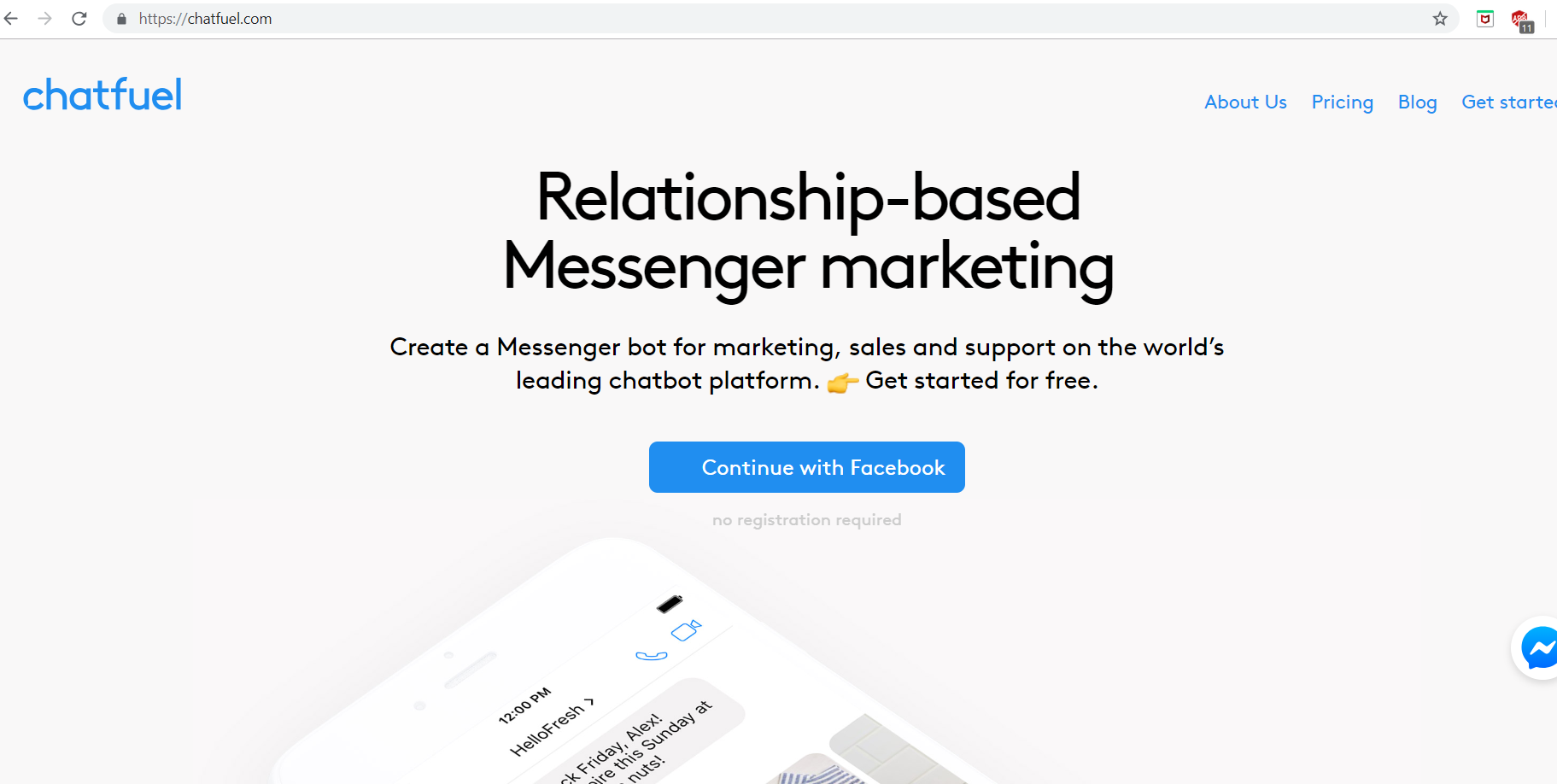
Image Source: chatfuel.com If you are logged into Facebook, it will ask for permission to link your Chatfuel account to your Facebook.
2. Create a page on Facebook:
Go to your Facebook account> Home Page>Under the explore options, select Pages> Create a page of your choice.
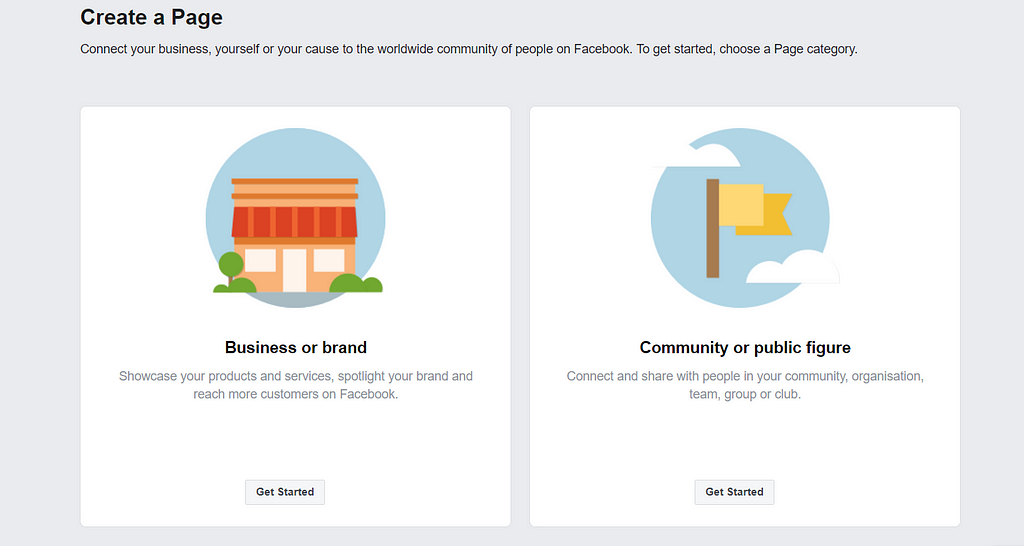
3. Chatfuel has to be linked to the Facebook account to deploy bots. So it requires permission to use the Facebook account:
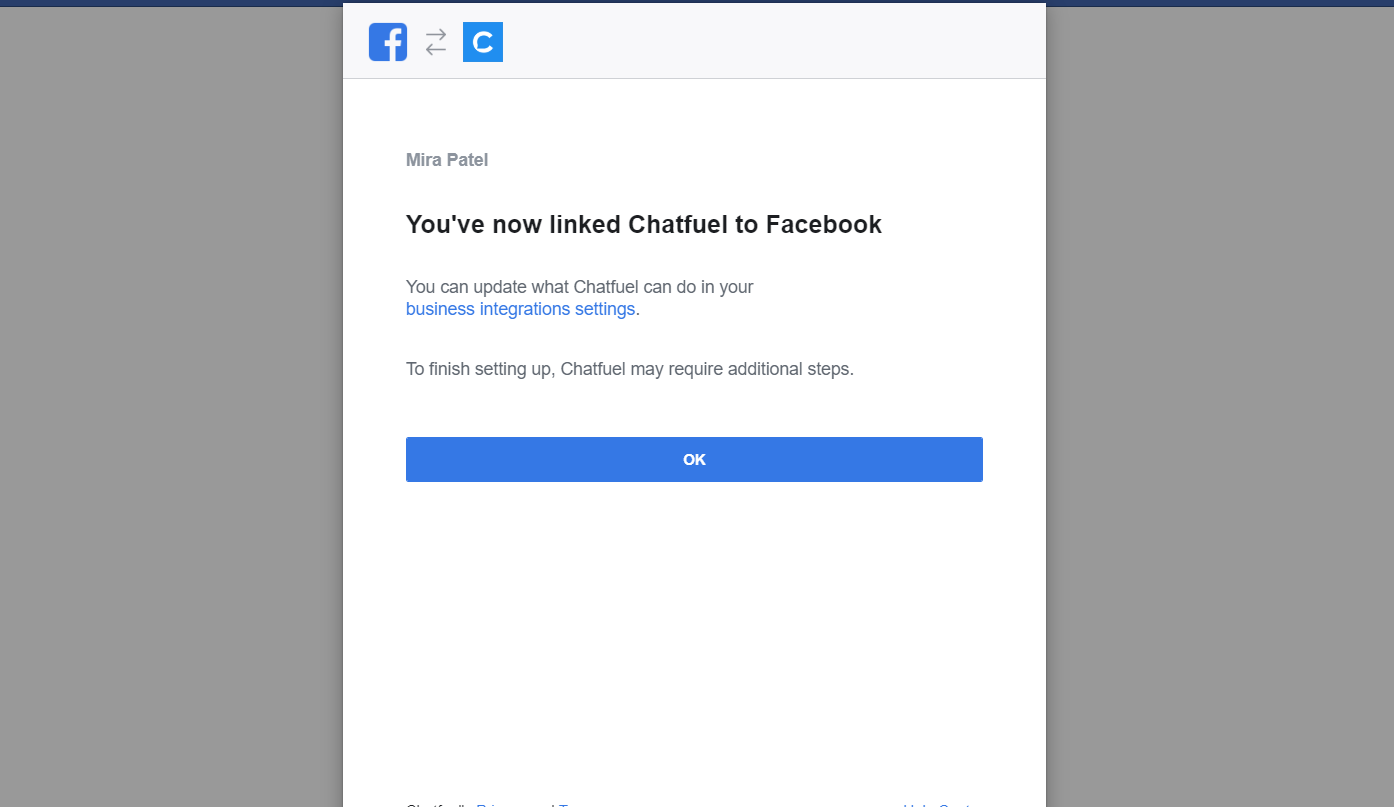
4. Go to https://dashboard.chatfuel and link your Bot page to Chatfuel. Let’s name it city tour guide. Click CONNECT TO PAGE, and you will be taken to Bot editor.
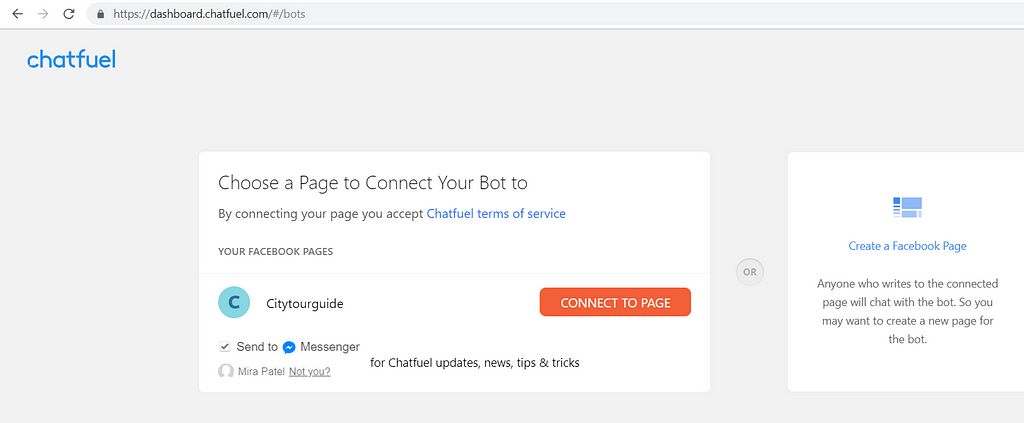
5. The name of the bot is set to My Bot. It has a URL, which you can see by the side of the name. These URLs start with m.me. You might notice that the bot comes with a Welcome message built-in. On the left menu, you will see the number of options.
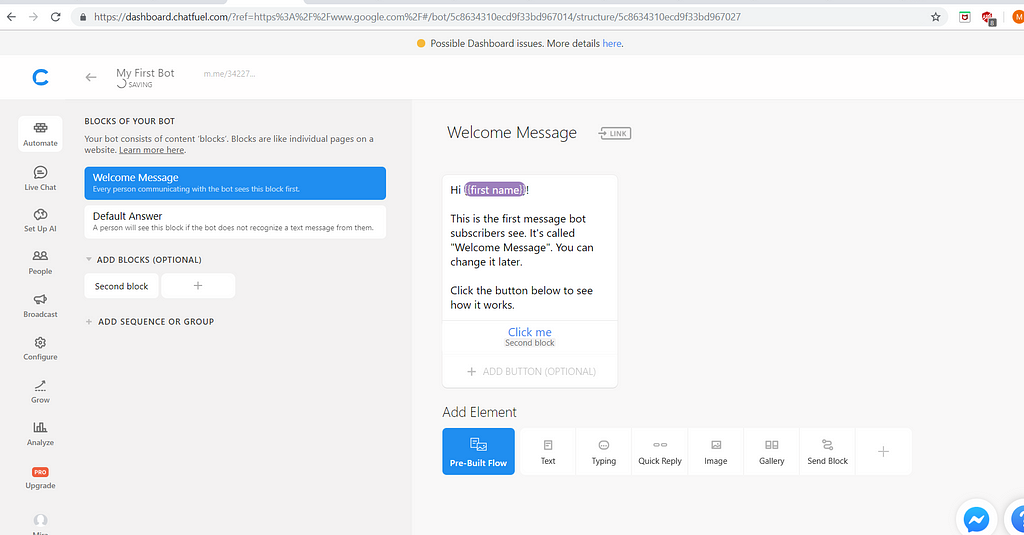
Trending Bot Articles:
2. Automated vs Live Chats: What will the Future of Customer Service Look Like?
4. Chatbot Vs. Intelligent Virtual Assistant — What’s the difference & Why Care?
6. Go to the Messenger URL start your first conversation with the bot, which will open Facebook Messenger in the browser tab.
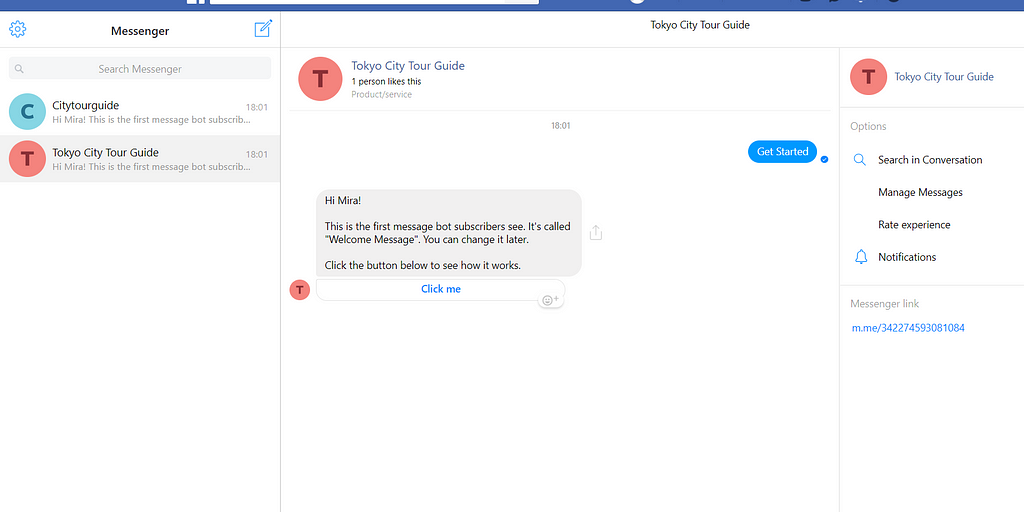
To get started with the conversation, just hit the “get started” button.
THERE YOU GO!!
Your conversation with the bot has just started and the bot has sent you a welcome message. The bot greets you by your name because you have given access to your info on Facebook.
BASIC BUILDING BLOCKS
Before building the bot, we will look at the basic building blocks:
i. BLOCKS: Under the bot structure tab, there are two types of blocks, build-in and user-defined. Welcome Message and Default Message are the two build-in blocks. We will be building user-defined blocks to implement the conversation capability of the chatbot. Each bot can contain one or more cards.
ii. CARDS: Cards are used to send messages to the deployment platform. There are many types of cards available. Text cards are the basic types of cards which include text messages and optional buttons. Other cards include images, quick replies (button arrays), lists, and gallery.
iii. BUTTONS: Buttons are used to provide users with response options and it also includes quick reply buttons.
iv. PLUGINS: There are number of plugins available. They are used to used to carry out special tasks instead of just responding to the user.
v. ATTRIBUTES: Attributes are like placeholders where we can store data temporarily during the conversation.
LET’S START BUILDING OUR BOT!
Now, let’s add a WELCOME MESSAGE!
- We can now edit the default text and add our welcome message.
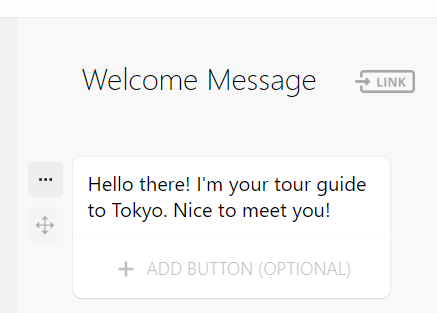
2. Now, by adding the text card, let’s add a follow-up text card and ask the user a question. Example “What would you like to do today?”
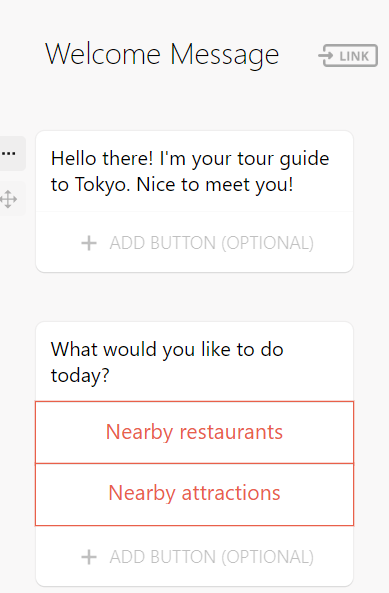
3. Now, we can add buttons like nearby attractions and nearby restaurants to the text card. You can add up to three buttons to the text card.
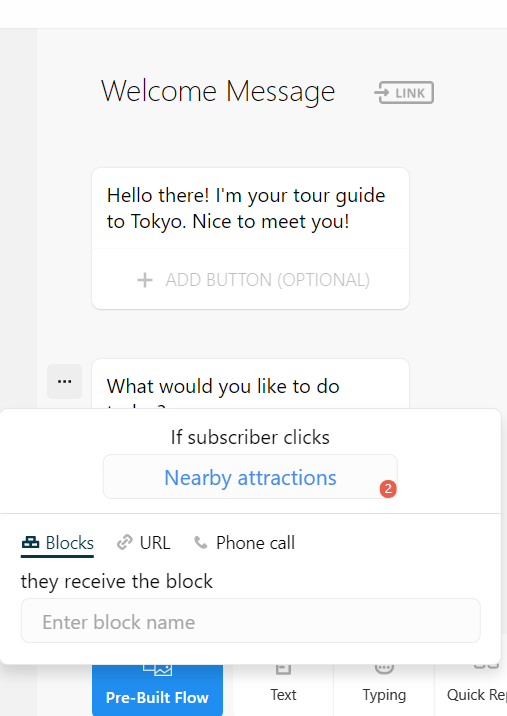
4. Button responses like nearby attractions and nearby restaurants needs to be attached to a block so that when the user hits the button the chatbot should know what to answer.
5. Let’s add BLOCKS to the bot structure tab, which creates an Untitled Block on the right-hand side.
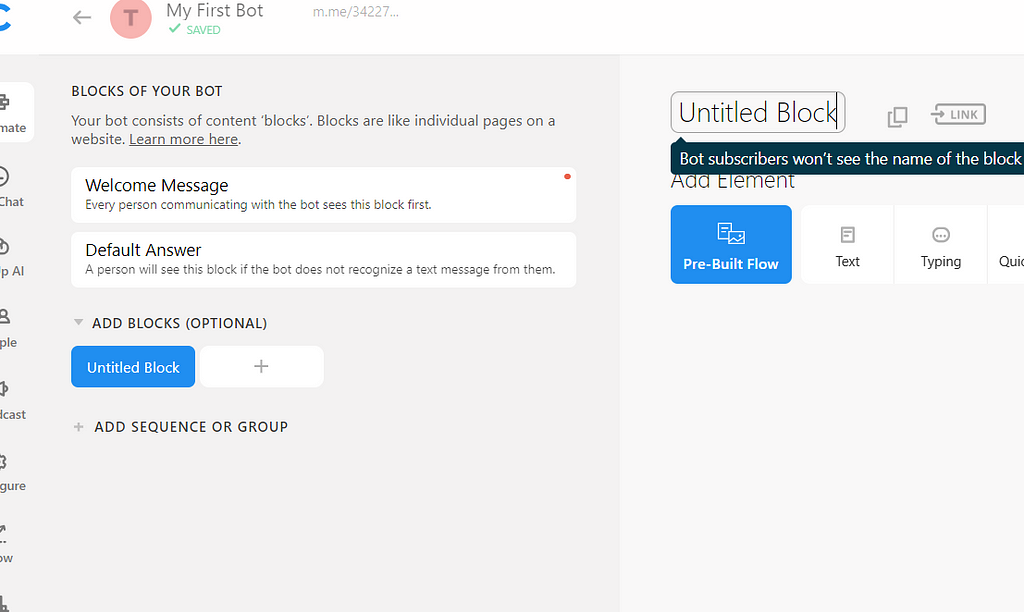
6. Let’s add two blocks for now, “NearbyAttraction” and“NearbyRestaurant”.
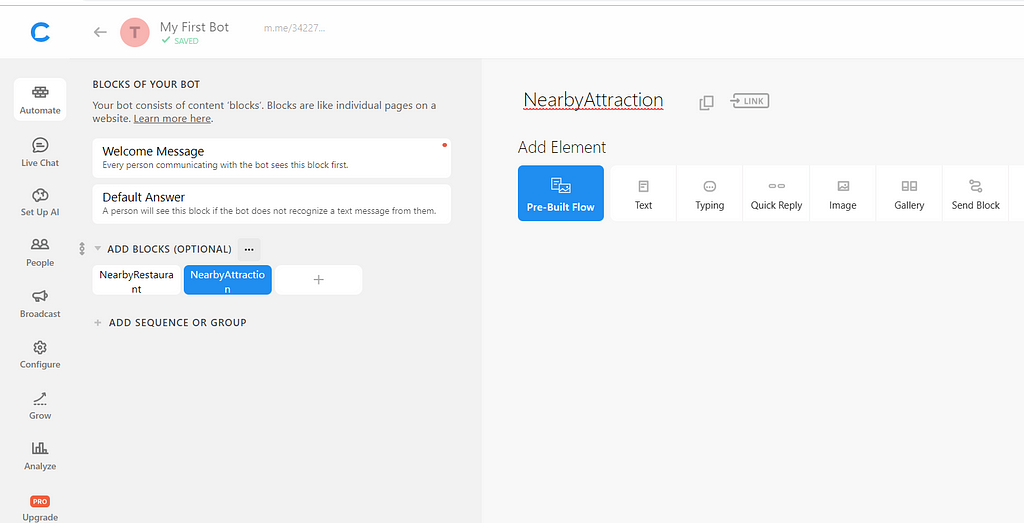
7. Now, let’s go back to the buttons and assign the given blocks to them.
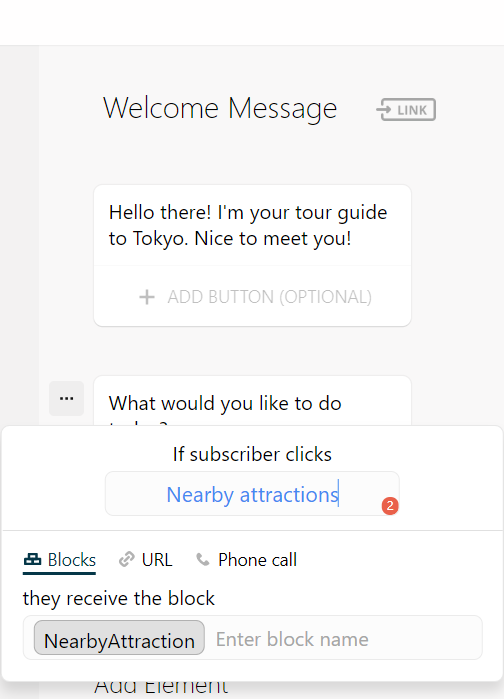
8. For each block, you created, add content by adding appropriate cards. Remember, each block can have more than one card. Each card will appear as a response, one after another.
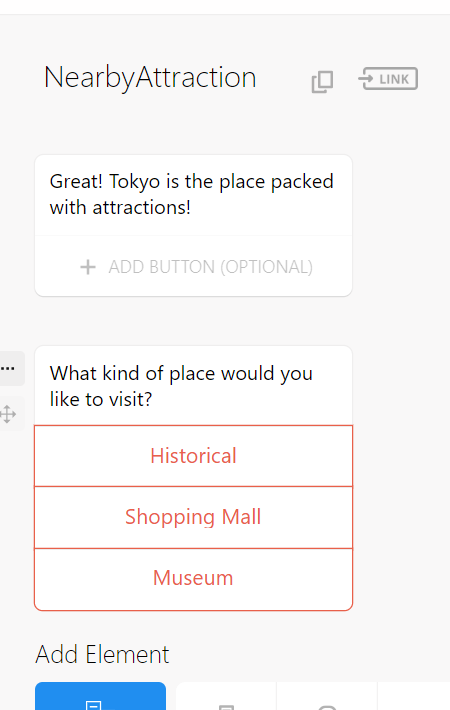
Similarly, for restaurants, we add the text cards with buttons
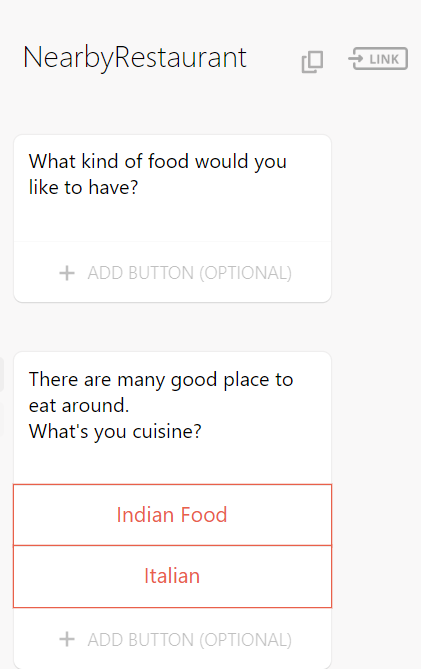
WELL DONE! You can now test the bot by clicking the TEST THIS CHATBOT button in the top-right corner of the editor
Don’t forget to give us your 👏 !



Building a Chatbot using Chatfuel was originally published in Chatbots Life on Medium, where people are continuing the conversation by highlighting and responding to this story.








